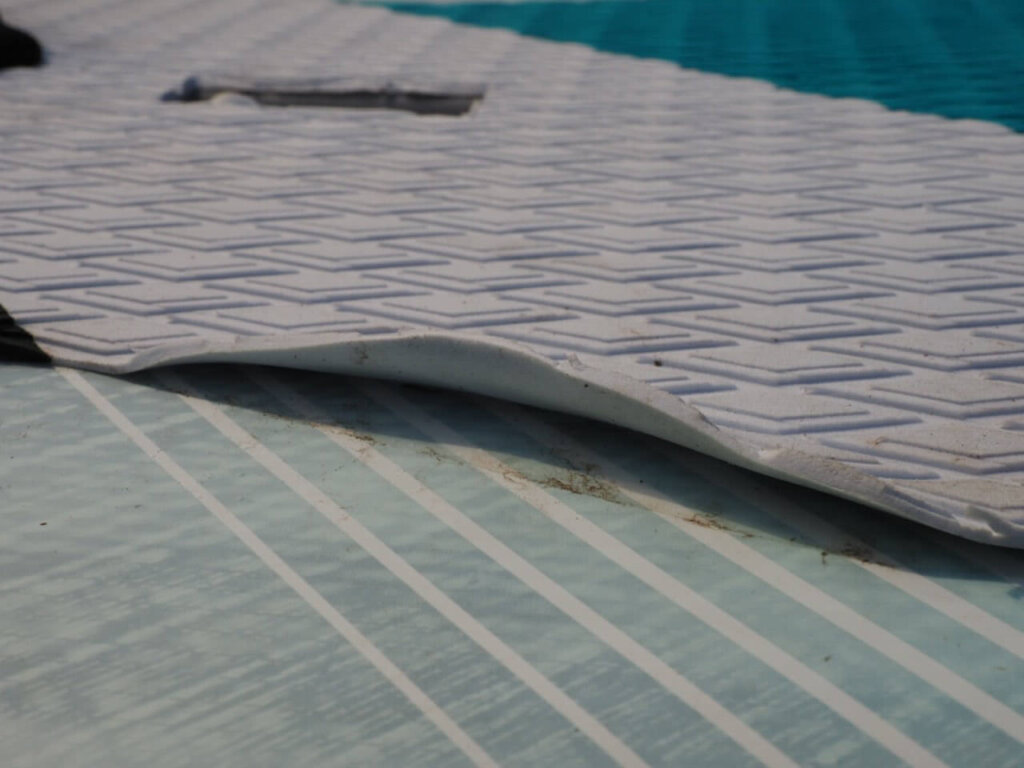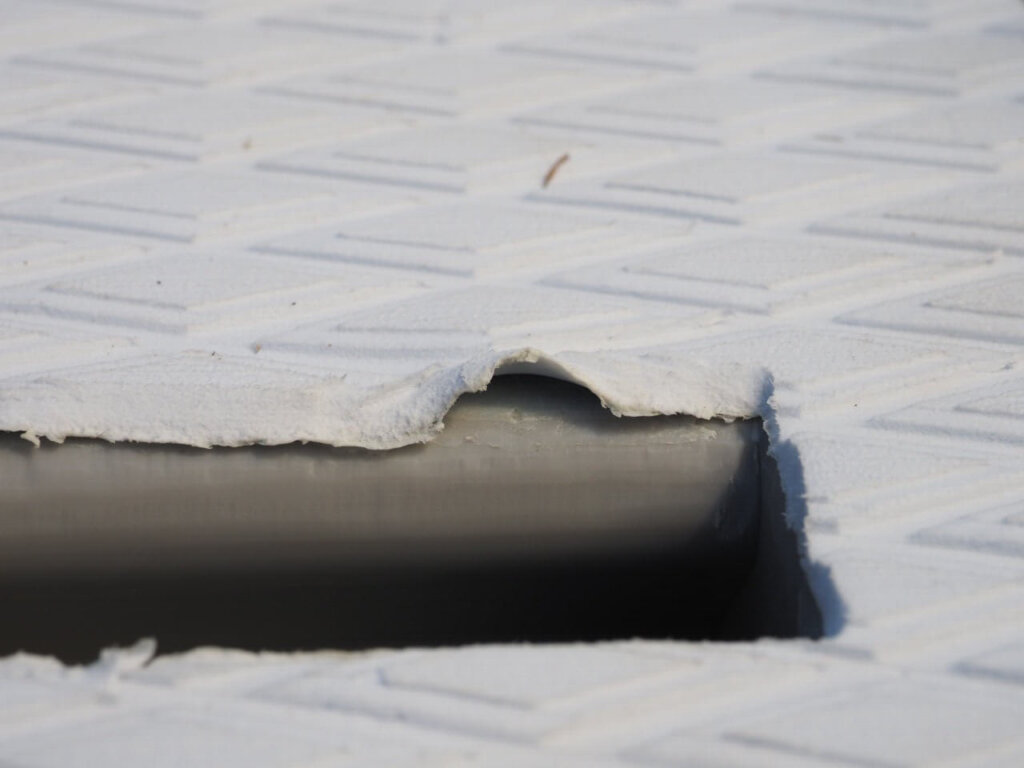Gong is a popular brand in the Netherlands and has its roots in golf surfing and supping. The step to Wingfoilen makes sense. The French brand Gong is characterized by offering products directly through their webshop for a competitive price. We have tested 2 Gong Zuma foilboard in the wood versions, the 6’3″ version with 105 liter volume and the large 6’9″ version with 140 liters. Under the board we used the Gong Allvator XL Read our findings.
Gong Zuma Wood
6’3″ | 186 cm L | 73 cm B | 105 L | 7,7 Kg | € 509,-
6’9″ | 201 cm L | 79 cm W | 140 L | 9.0 Kg | € 509,-
The Zuma is actually originally a golf supboard which features a double US box. The boards look neat, with large pads to stand comfortably on. There are also 3 foot straps that you can screw on the board if you want. And that for only € 509,- (then you have to pick it up yourself in France). If you have it delivered at home, you will have to pay € 70! On the back of the board there is an eye for a necessary leash, but the leash is not there, you can buy it as a loose accessory.
In the middle of the deck is an insert to make it easy to carry the board. If there is a wingfoil under the board, it turns out that the position of the insert is incorrect. Also, an insert in the bottom would have been handy, which is more useful to use if you wear the board with wingfoil. The Starboard Wingboards do have an insert in the bottom and in the right place. The bottom is flat there are no concaves in it as with several other brands to accelerate the take off. There doesn’t seem to have really been much attention to the shape. Especially with the boards that have just come on the market the shape is basic and dated.
Stable and friendly
Then the most important thing. How do they do it on the water? Especially the 6’3″ feels nice and compact and light. The Gong Zuma 6’9″ is clearly larger and feels relatively heavy. Both boards are relatively wide. This makes the boards nice and stable. On both boards it is also very easy to stand up and sail away. With a weight of up to 85 kg (and a good sense of balance) you don’t need a bigger board than the 6’3″. If you choose bigger, everything feels a lot logger. This detracts from the feeling of freedom and the playfulness that is so typical of wingfoiling. And that’s the feeling we have at the 6’9″. It feels a bit heavy and dull. Yes it is more stable, also comes up a little faster. Once in the air, we therefore become less enthusiastic compared to the smaller board.
Drop downs capture the board just fine. We’ve only had a few times when the nose of the board bit into the water. Although this depends on the length of the foil mast and where the wingfoil is positioned in the US boxes. A friendly all-rounder that is the feeling that stays with us. Great to start with wingfoilen, nice wide with an average performance. Partly the performance depends on the wingfoil and the wing of course. About the wingfoil below more.
More wind needed to get up
Compared to the Starboard Wingboard Lite tech, the Gong Zuma boards are less likely to take off. With the same wing and wingfoil we really needed 2 to 3 knots more to get away. And then we even compared it to a board with even less volume (The starboard 5’8″ has 88 liters of volume). We can clearly see here that the conventional (or outdated what you want) shape obstruct to get away quickly especially with less wind. That’s a shame, because you want to speed up your flight as quickly as possible.
Quality issues / warranty
They say sometimes; ”Everything has a price’ and that seems to be the case here. When we received the 6’9″ the standard fastening sets did not appear to fit in the US box of the 6’9″. This while the same one fit as in the 6’3″. You don’t just drive to France. And we were told by e-mail that everything is checked in their factory and that it should not be too easy. When asked if we should use a hammer to get the sleeves in the right place, we unfortunately did not get a response. Then there was radio silence from Gong! In the end, we solved it using our tools, but we found the reaction and the lack of a solution disappointing.
The 6’3″ is also not trouble-free. After about 20 sessions we see that in various places the pads let go. Can easily be glued back together, but here does not seem to be the right glue to be used.


Friendly wingfoil
We tested both boards in particular with the Gong Allvator Rise XL foil. This foil fits perfectly with the character of the board. We have experienced the foil as friendly, relatively stable and not really very fast. Want to know more about the Gong Allvator Rise XL foil? Soon there will be a comprehensive review on this wingfoil.
The Gong Allvator Rise XL (front wing of 2100 cm2) fits best with the Gong Zuma 6’9″. For the Gong Zuma 6’3″ we think the L (front wing 1,900 cm2) fits better. We expect the smaller version to feel a bit more playful and give less (unnecessary) lift to this smaller board.
Long mast is fine
The Gong wingfoil Allvator Rise has a mast of 90 cm long. Although you have to go a little deeper into the water before you can sail away, we like a long mast. It literally gives you more space between hitting the water and getting the wingfoil out of the water. Unfortunately, too much attention has been paid to weight savings because we do not find the mast stiff enough. This makes it feel a bit wobbly in the water and during wingfoiling you also feel more instability when there are waves.
For whom?
If you want to start for little money and don’t set too high demands on the material and performance then the Gong Zuma is a great choice. Our advice is to choose a board as small as possible, which suits your weight. Too big a board quickly comes at the expense of the fun we have noticed.
If you have more ambition and want something for the longer term, there are now better (and more expensive) boards on the market that have cleverness and a more advanced shape will make you wingfoil faster.
Conclusions
We have a bit of mixed feelings about the Gong Zuma. On the one hand, for little money you have nice boards that are really easy to wingfoil. Very unfortunate is that the oh so important start clearly requires more effort and wind to make enough speed to get on the foil than the latest generation of wingfoilboards. Anyway, these boards cost a lot less than the other A-brands.
In addition, we find it a blemish on the blasphemy that the pads let go so quickly in various places and that a problem is not better picked up.
What we do agree on is that the boards are best suited for the novice wingfoiler, but that the wingfoilers who want more are quickly looked out for these boards (especially in combination with the tested wingfoil).


